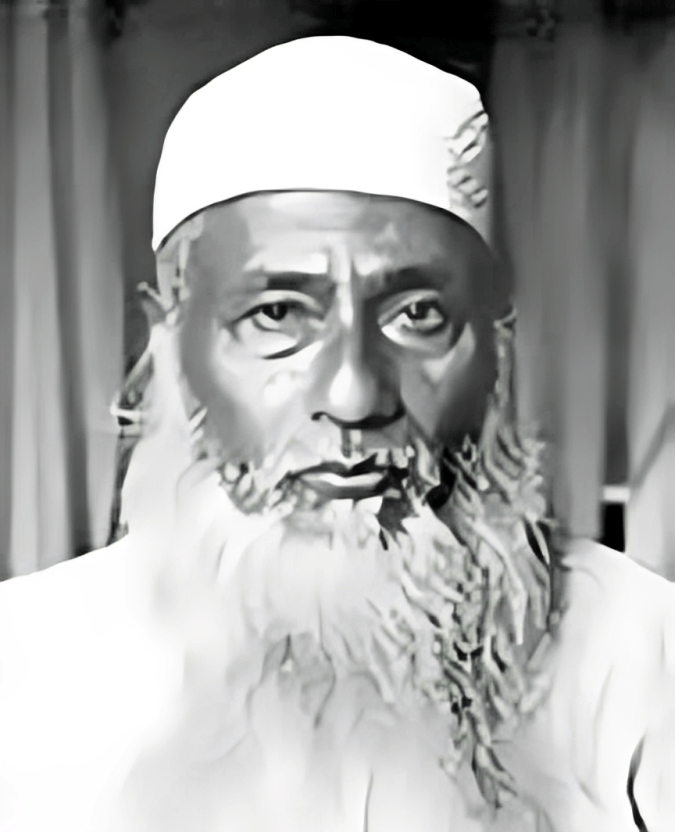Abdul Hamid Bhashani was born in 1885 at a village Dhangara of the then Sirajganj, sub division of Pabna District. He lost his father Haji Sharafat, a small shop owner in 1889. The rest of his family died of an epidemic in 1894. In 1907, he was sent to Dar-ul-Aloom, Deoband where he met some prominent Muslim scholars including Sheikh-ul-Hind Mahmud-ul-Hasan.
In 1917 he became the member of the Indian National Congress but mainly worked for the peasants in Pabna-Mymensingh areas. He was associated with the Khilafat Movement in Bengal and also participated in the Non-Cooperation Movement launched by Gandhi in 1921. As a result he was imprisoned for some time. The largest ‘Peasant Rally’ held in Bengal during the British rule was organized by Bhashani at Kawakhola Maidan in Sirajganj District in December 1931. The rally adopted some resolution in the interest of the farmers including the abolition of zamindari system. Bhashani did a lot in the educational sector and established many maktabs, schools and colleges for both boys and girls in the provinces of Bengal and Assam. In 1937 he joined All India Muslim League and the same year he was elected as a member of the Assam Provincial Constituent Assembly. He worked effectively in disseminating the message of Muslim League among the masses of East Bengal. Before Sylhet was incorporated in Pakistan, he was President of the Provincial Muslim League of Assam. He campaigned for the success of the Sylhet referendum day and night with great vigor and enthusiasm.
After two years of partition in 1949 he formed ‘East Pakistan Awami Muslim League’, and remained its President for eight long years (1949-1957). Bhashani started addressing hundreds of meetings throughout the province of East Bengal informing the masses about the neglectful and indifferent attitude of the Government of Muslim League towards the people of Bengal. He was not in favor of the Basic Principle Committee Report and presided over a large public meeting at Paltan Maidan on 11th December 1953 observing ‘anti-BPC Protest Day’. The ‘Bengali Language Movement’ initiated by the student community of the Dhaka University also received great support from Bhashani and his Awami League. In a public meeting in Dhaka on 4th February 1952, he again criticized the anti-Bengali policies of the ‘ruling class’ of the west wing and vowed to continue his struggle till he achieved the goal of making Bengali as one of the State Language of Pakistan. Because of these activities, he was sent to jail on April 10, 1952 and released on 21st April 1953.
Bhashani criticized the ‘One Unit’ plan of Suharawardy and also opposed the ‘Parity Principle’ in the Constitution of 1956 because in his view it was tantamount to denial of the Bengalis’ numerical majority in the central legislature and the central services of Pakistan. Due to the deplorable state of political affairs in mid 1950s Bhashani started demanding complete separation of the east wing. He opposed the defense pacts of SEATO and CENTO. After Egypt nationalized the Suez Canal in July 1956, and the sympathies of the masses were with Egypt, Bhashani showed his all-out support to Egypt. He called for “Egypt Day” that the government of East Pakistan was obliged to declare it as the public holiday.
Bhashani left Awami League and formed his own “National Awami Party” in July 1957. He became its president while Mahmood-ul-Haq Usmani was its General Secretary. The main reason for leaving Awami League was the disagreement with Suharawardy and the emerging leader Mujeeb-ur-Rehman on matters like foreign policy and provincial autonomy. After some time NAP was also divided into two groups on the issue of foreign policy. One, led by Bhashani, was pro China and the other led by Wali Khan was pro Soviet Union. During the rule of Ayub Khan, he was imprisoned like many other political leaders. But when he came out, Ayub Khan sent him as a member of the official delegation to China to take part in their ‘Independence Day’ celebrations in 1962. As soon as the movement started against Ayub’s government, Bhashani emerged on the political scene and raised voice for the Bengalis. In 1970-71 elections, he supported Mujib but he himself didn’t participate in the elections. He strongly demanded independence of East Pakistan.
East Bengal was separated from Pakistan in 1971. Although Bhashani was not in favor of Mujib, still he played a vital role as an opposition leader for the establishment of democratic rule in Bangladesh. With the passage of time Mujib’s government started to decline. Bhashani still playing his role as an opposition leader started his fast unto death against Mujib’s government. But he and his party failed to mobilize mass campaign.
He established Santosh Islamic University in 1970 but he didn’t have time and resources to fulfill his dream of making it a proper university. Bhashani led ‘Farraka March’ in May 1976 to demonstrate his reaction against India on the India-Bangladesh water dispute. Up to the last moment he did not abandon his political activities. While Maulana Bhashani was addressing a conference of ‘Khudai Khidmatgars’ at Santosh on 13th November, the same day he fell ill and was shifted to Dhaka Medical College Hospital where he breathed his last on 17th November 1976 and was buried at Santosh.
This article was last updated on Monday, Jan 05, 2009






